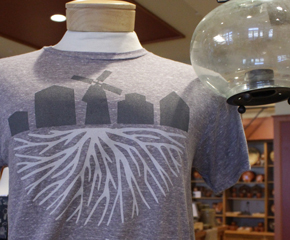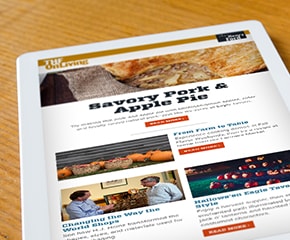What If
Throughout George W. Carver’s life, he balanced two interests and talents that may seem at odds – the creative arts and the natural sciences. Skills of observation, experimentation, replication, and communication applied to both art and science, making George W. Carver as comfortable in the sciences as in the arts. From a child I had an inordinate desire for knowledge, and especially music, painting, flowers, and the sciences… George W. Carver
George Washington Carver, a well-known African American agricultural scientist based at Tuskegee Institute in Alabama, wrote Saving the Wild Plum Crop (1907) to convince Alabama’s businesses, as well as its citizens, to take full advantage of the rich native crops at their disposal.
“Macon and adjoining [Alabama] counties have been unusually blessed in the quantity, variety, and quality of its wild plums. They vary in size from a half to one inch in diameter, and in flavor from sugary sweetness to sour and bitter. In color, from lemon yellow to crimson, scarlet and black, making possibilities for many pleasing combinations for the eye and palate.”
![[WhatIf]-Carver_inline_THF27862](/images/default-source/default-album/whatif--carver_inline_thf27862.jpg?sfvrsn=875b3801_0)
The words Carver used indicated that he saw the world from an artist’s perspective, conveying vivid details to his readers. Carver, in his mid-40s when he wrote Saving the Wild Plum Crop, used his artistic conviction to elucidate the scientific characteristics of a wild plum. He had navigated this intersection between art and horticultural science for most of his life, and he continued to balance art and science until he died.
Plants and Art Combine Early
Carver systematically collected and cultivated plants from an early age. He recalled that, “day after day I spent in the woods alone in order to collect my floral beautis and put them in my little garden I had hidden in the brush not far from the house, as it was considered foolishness in that neighborhood to waste time on flowers.” He pursued many other interests, too. As a child, he wanted to learn about math, music, fine art and flowers.
Carver wanted to become an artist, but his art teacher at Simpson College, Etta Budd, encouraged him to study botany at Iowa Agricultural College [today Iowa State University (ISU)], where her father taught horticulture, instead. Ms. Budd may have done this because she recognized within Carver a talent for science that she believed her father could cultivate. In any case, Carver decided to enroll at ISU in 1891, and he excelled in botany and horticulture. The plant sciences became a natural outlet for his artistic talents.
The Artist’s Eye, the Scientist’s Hands, and the Possibilities of Plants
Understanding plants required Carver to collect them, as he had during his childhood, and relocate them from their natural habitats to conservatories. Carver used weeding tools to extract specimens with roots intact, necessary for substantial study. While living in Kansas, Carver amassed a “collection of about five hundred plants [housed] in a neat conservatory adjoining the residence of his employer.” His knowledge of plants translated into practical uses, particularly as natural remedies or as patent medicine ingredients. The fledgling botanist held the secrets that purveyors of patent medicines sought as they concocted cure-alls from organics and marketed them to consumers seeking relief from maladies.
In fact, one of the growth industries of the late 19th century related to innovation in plant science: Plant fibers had commercial uses. In 1880, both the Walter A. Wood Harvesting Machine Company and Deering Harvester Company began selling a self-tying binder that used twine rather than metal to tie bundles of grain. Not to be outdone, McCormick Company put its binder on the market in 1881. A blend of sisal and henequen, both plants in the same family as the yucca, became the preferred material in twine. Carver likely encountered farmers and harvest crews with twine binders in the years he spent homesteading 160 acres near Beeler, Kansas, in the late 1880s. He later recalled that he based his painting “Yucca and Cactus” on his memories of the western plains.
![[WhatIf]-Carver_inline_THF170566](/images/default-source/default-album/whatif--carver_inline_thf170566.jpg?sfvrsn=f75b3801_0)
Carver’s mentor at Iowa State, Louis H. Pammel, had documented yucca pollination in a report on flower pollination. It appeared in the 1891 report of the Iowa State Horticulture Society. Carver researched the cultivation and management of cacti and presented his findings at the 1892 meeting. Both these factors could have inspired him to paint the larger-than-life-size “Yucca and Cactus.” This painting received the first major public viewing of his work, appearing alongside that of other Iowa artists in the Iowa State Building during the Columbian Exposition in 1893. It received an honorable mention.
Botanical Drawing for Horticulturalists
In the days before photographs, botanists and horticulturalists depended on precise drawings that captured the essence of a plant’s physiology, its reproductive organs, its responses to pathogens, and its commercial potential. Carver approached botany as both a scientist and an artist. As a scientist, Carver conducted fieldwork to discern and analyze botanical information. As an artist, Carver used his keen powers of observation and his ability to captivate audiences to convey this information. Members of the Iowa State Horticulture Society so valued his presentations that they elected him an honorary member, a title conferred on a few non-dues paying members, each year he presented, in 1892, 1893, 1894, and 1895. Professor Budd served as secretary of the Society during these years.
![[Whatif]Carver_inline_THF287094](/images/default-source/default-album/whatif-carver_inline_thf287094.jpg?sfvrsn=2d513801_0)
Suburbanization created new opportunities for horticulturalists, who worked in a specialized branch of agriculture focused on fruit, fruit trees, and flowering plants. Developers sought decorative plants for residential landscaping. Botanical drawings conveyed to potential clients the beauty of plants and their utility in domestic settings. Carver contributed his own drawings for the edification of horticulturalists and botanists even as photographic printing became commercially viable. By the early 1890s, changes in printing technology, specifically halftone and photolithographic techniques, made mass-produced botanical photographs possible. However, botanical drawing remained a part of the Iowa State curriculum, and Carver’s ink tracings and original drawings reached Iowa horticulturalists via their annual report.
Finding Unexpected Uses for Natural Resources
Carver quite literally created art from nature. During his years at Tuskegee Institute, a private college serving African Americans in Alabama and beyond, he created new uses for a variety of organic and inorganic materials. He and his laboratory assistant, Austin W. Curtis, Jr., extracted pigments from Alabama clay. Carver used art to convey the potential of the minerals in this natural resource. He drew a landscape and explained the pigment’s attributes in a personal note to his friend, Henry Ford.
Letter and Drawing by George Washington Carver Sent to Henry Ford, 1941
Artifact
Letter (Correspondence)
Date Made
28 March 1941
Summary
George Washington Carver and Henry Ford became friends in the late 1930s, drawn together by a mutual interest in developing new industrial products from the fruits of the soil. Carver's warm letters to Ford, Clara Ford, and Ford's secretary Frank Campsall speak to the genuine depth of the friendship. Carver often gives Ford advice on research avenues to pursue and suggests recipes for natural health.
Place of Creation
Object ID
64.167.285.27
Credit
From the Collections of The Henry Ford. Gift of Ford Motor Company.
Location
Not on exhibit to the public.
Get more details in Digital Collections at:
Letter and Drawing by George Washington Carver Sent to Henry Ford, 1941
What is The Henry Ford?
The national attraction for discovering your ingenuity while exploring America’s spirit of innovation. There is always much to see and do at The Henry Ford.
Carver’s reputation did not grow from his ability to combine art and science. Instead, he gained name recognition because of his efforts to create marketable products from crops that poor southern farmers could grow, including sweet potatoes, peanuts and other horticultural products, such as fruits and vegetables. A correspondent with TIME labeled him the greatest African American scientist alive in a 1941 article entitled, “Black Leonardo.” The article also itemized some notable achievements: “285 new uses for the peanut, got 118 products including vinegar, molasses, and shoe blacking from the sweet potato.”
Teaching Farm Families and Children
Carver moved to Tuskegee Institute in 1896. He illustrated his messages to black farmers with his own drawings of plant physiology, cultivation techniques, and soil treatments. These helped him convince farmers to change their farming practices with a goal toward improving their standard of living. Carver believed poor farmers could accomplish this by raising crops and livestock that could help them vary their diet from the routine “meat, meal, and molasses” that many poor farm families ate, and that would provide additional marketable products.
![[WhatIf]Carver_inline_THF213278](/images/default-source/default-album/whatif-carver_inline_thf213278.jpg?sfvrsn=79513801_0)
Carver advocated for careful observation of nature throughout his career, joining a larger movement supporting nature study. In Progressive Nature Study, a pamphlet published in 1897, Carver explained that “the study of Nature … is the only true method that leads up to a clear understanding of the great natural principles which surround every branch of business in which we may engage.” He encouraged teachers to provide each student a slip of plain white or manila paper so they could make sketches. Neatness mattered – and proved no easy feat given the lack of pencils with erasers. As Carver explained, the grading scale “only applies to neatness, as some will naturally draw better than others.” Encouraging students to explore and document their natural surroundings increased self-awareness but could also result in ways to diversify farm incomes.
![[WhatIf]Carver_inline_THF122750](/images/default-source/default-album/whatif-carver_inline_thf122750.jpg?sfvrsn=1b513801_0)
The Artist-Scientist’s Legacy
George Washington Carver received numerous honors during his fifty-year career as an agricultural scientist. The Roosevelt Medal in 1939 recognized him as “one of the foremost agricultural chemists in the country and as a vital factor in the economic and social progress of the South,” but his success in the sciences was continuously aided by and blended with his talent in the arts. Carver’s artistic lens helped him promote his scientific discoveries – allowing rural farmers access to the economic opportunities that his agricultural discoveries helped secure.
Prepared by Debra A. Reid, Curator of Agriculture and the Environment, with Deborah Evans, Master Presenter, The Henry Ford.
Carver is known far and wide for his genius in producing new products and new uses for age old stand-bys.Claude C. Tedford, journalist for the Black Dispatch (Oklahoma City, Oklahoma).
Browse Collections
Portrait of George Washington Carver, 1944
Artifact
Portrait
Date Made
1944
Summary
Henry Ford commissioned his personal artist, Irving Bacon, to paint this portrait of Ford's friend, the agricultural scientist George Washington Carver. Carver sat for the painting during his visit to Dearborn in 1942. Carver, who loved plants, the soil, and farmers, is pictured in a meadow. He is wearing his customary old suit with boutonniere and is holding a milkweed pod.
Place of Creation
Keywords
Object ID
00.28.68
Credit
From the Collections of The Henry Ford.
Get more details in Digital Collections at:
Portrait of George Washington Carver, 1944
What is The Henry Ford?
The national attraction for discovering your ingenuity while exploring America’s spirit of innovation. There is always much to see and do at The Henry Ford.

Lithograph, "Plumcots, Samples of a Distinct New Species of Fruit Produced by Luther Burbank" 1909
 Details
Details
Lithograph, "Plumcots, Samples of a Distinct New Species of Fruit Produced by Luther Burbank" 1909
Artifact
Print (Visual work)
Date Made
1909
Place of Creation
Object ID
45.55.9.1
Credit
From the Collections of The Henry Ford. Gift of Mrs. Luther Burbank.
Location
Not on exhibit to the public.
Get more details in Digital Collections at:
Lithograph, "Plumcots, Samples of a Distinct New Species of Fruit Produced by Luther Burbank" 1909
What is The Henry Ford?
The national attraction for discovering your ingenuity while exploring America’s spirit of innovation. There is always much to see and do at The Henry Ford.
Yucca for the Hair and Scalp, 1890-1901
Artifact
Medicine bottle
Date Made
1890-1901
Summary
People have sought a cure for hair loss for thousands of years. In the late nineteenth-century, the makers of "Yucca for the Hair" marketed their concoction as a cure for baldness, dandruff, and other diseases of the scalp. The proprietors of this patent medicine claimed the plant-based extract invigorated the scalp, promoted hair growth and rendered hair "soft, glossy and luxuriant."
Keywords
Object ID
00.4.5767
Credit
From the Collections of The Henry Ford.
Location
Not on exhibit to the public.
Get more details in Digital Collections at:
Yucca for the Hair and Scalp, 1890-1901
What is The Henry Ford?
The national attraction for discovering your ingenuity while exploring America’s spirit of innovation. There is always much to see and do at The Henry Ford.
Walter A Wood Twine Self Binding Harvester, 1881
Artifact
Trade catalog
Date Made
1881
Creators
Object ID
91.315.208
Credit
From the Collections of The Henry Ford. Gift of Christine Dillon.
Location
By Request in the Benson Ford Research Center
Get more details in Digital Collections at:
Walter A Wood Twine Self Binding Harvester, 1881
What is The Henry Ford?
The national attraction for discovering your ingenuity while exploring America’s spirit of innovation. There is always much to see and do at The Henry Ford.
Letter and Drawing by George Washington Carver Sent to Henry Ford, 1941
Artifact
Letter (Correspondence)
Date Made
28 March 1941
Summary
George Washington Carver and Henry Ford became friends in the late 1930s, drawn together by a mutual interest in developing new industrial products from the fruits of the soil. Carver's warm letters to Ford, Clara Ford, and Ford's secretary Frank Campsall speak to the genuine depth of the friendship. Carver often gives Ford advice on research avenues to pursue and suggests recipes for natural health.
Place of Creation
Object ID
64.167.285.27
Credit
From the Collections of The Henry Ford. Gift of Ford Motor Company.
Location
Not on exhibit to the public.
Get more details in Digital Collections at:
Letter and Drawing by George Washington Carver Sent to Henry Ford, 1941
What is The Henry Ford?
The national attraction for discovering your ingenuity while exploring America’s spirit of innovation. There is always much to see and do at The Henry Ford.
Some Possibilities of the Cow Pea in Macon County, Alabama, 1910
Artifact
Bulletin
Date Made
1910
Summary
Among George Washington Carver's scientific contributions were the bulletins he issued from the Experiment Station of the Alabama state extension service that he established at the Tuskegee Institute. Carver wrote what he called "threefold" agricultural bulletins, with information for farmers, teachers, and housewives. This bulletin taught readers that cow peas were good for depleted soils as well as good to eat.
Place of Creation
Keywords
Object ID
64.167.285.23
Credit
From the Collections of The Henry Ford. Gift of Ford Motor Company.
Location
By Request in the Benson Ford Research Center
Get more details in Digital Collections at:
Some Possibilities of the Cow Pea in Macon County, Alabama, 1910
What is The Henry Ford?
The national attraction for discovering your ingenuity while exploring America’s spirit of innovation. There is always much to see and do at The Henry Ford.

Discussion Questions
- What motivated George Washington Carver to innovate?
- What habits of an innovator did George Washington Carver illustrate?
- Which of these habits do you think was most important to his success?
- What are some of the problems of today and what innovator habits could you apply to solve them?
- Do you think you can be an innovator like George Washington Carver? Why or why not?
Fuel Your Enthusiasm
The Henry Ford aims to provide unique educational experiences based on authentic artifacts, stories and lives from America’s tradition of ingenuity, resourcefulness, and innovation. Connect to more great educational resources:




























